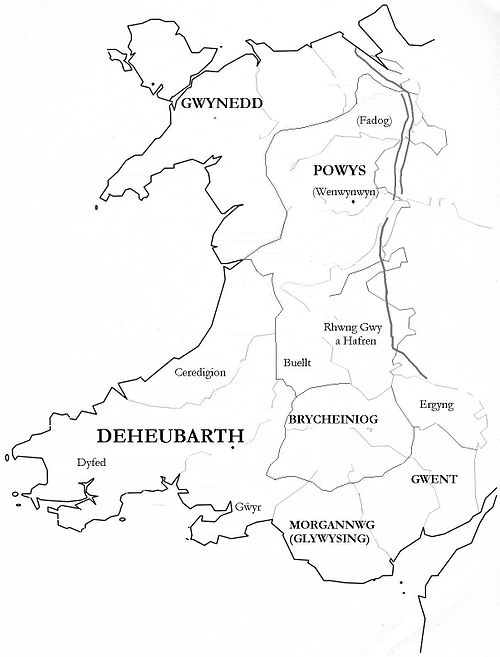Kingdom of Glywysing Teyrnas Glywysing (Old Welsh) | |||||||||||
|---|---|---|---|---|---|---|---|---|---|---|---|
| 5th century–c. 1055 (intermittently in union with Gwent/in Morgannwg) | |||||||||||
 Medieval kingdoms of Wales, showing Glywysing in the south | |||||||||||
| Capital | Cardiff | ||||||||||
| Common languages | Old Welsh | ||||||||||
| Religion | Celtic Christianity | ||||||||||
| Government | Monarchy | ||||||||||
| Historical era | Middle Ages | ||||||||||
• Formed after Roman withdrawal from Britain | Late 5th century | ||||||||||
• Various unions with Gwent | 6th century–c. 745 | ||||||||||
• Union in Morgannwg (underMorgan Hen ab Owain) | 942–974 | ||||||||||
| 1055–1063 | |||||||||||
• Union in Morgannwg | 1063–1074 | ||||||||||
• Becomes Morgannwg (underCaradog ap Gruffydd) | 1075 | ||||||||||
| |||||||||||
Glywysing was, from thesub-Roman period to theEarly Middle Ages, apetty kingdom in south-eastWales. Its people were descended from theIron Age tribe of theSilures, and frequently in union withGwent, merging to form Morgannwg.
Glywysing is said in medieval Welsh tradition to be named afterGlywys, supposedly an early king of the region. In reality, the name probably comes fromGlevum, the Roman name for what is nowGloucester, via a Latin name *Glevenses ('people of Glevum') or *Glevensis ('person from Glevum'). Thus the name suggests that the kingdom was named after invaders or migrants, or a particular ruler, from Glevum.[1][2]
According to 12th-century sources, after the death of Glywys, the kingdom was divided into threecantrefs named for his sons:[3]Penychen,Gwynllwg, andGorfynydd. These were typically ruled together by the head of the family and sometimes treated asappenage subkingdoms.
The borders changed over time, but it is generally thought that its lands originally lay between theAfon Llwyd and either theRiver Loughor, or theRiver Neath. At times they expanded eastwards in union with bothGwent andErgyng. The Gower had either returned or was inherited from Dyfed to Glywysing by 928 prior to the reign of KingMorgan the Old.[4] Today the area of Glywysing is known asGlamorgan.
First under KingMorgan the Generous (fl.c. 630-730) until the end of the reign of his descendantIthel (d. c. 745), and later again under KingMorgan the Old (r. 942-74), the kingdom merged withGwent and changed its name to Morgannwg or Gwlad Morgan in honour of the Morgan Kings.[4][5] During such unions Glywysing and Gwent seem to have been together or occasional sub-kingdoms or principalities of the Kingdom of Morgannwg.[4]
After the death of Morgan the Old, Gwent and Glywysing were separated again from 974 to 1055, but Glywysing alone was often referred to as Morgannwg. Both areas were conquered byGruffydd ap Llywelyn in about 1055, subsequentlyKing of Wales, but on Gruffydd's death in 1063, Glywysing was regained by the native lineage underCaradog ap Gruffudd.[4] Morgannwg, the union between Gwent and Glywysing, was reconstituted. How this occurred is unclear; possibly the Kings of Glywysing were also Kings of Morgannwg and the Kings of Gwent were semi-independent under-Kings, or vice versa.[4]
With Gwent increasingly overrun by theNorman conquest of Wales, the last native King of Morgannwyg and Glywysing wasIestyn ap Gwrgan (1081–1090), who was subsequently deposed byRobert Fitzhamon. Iestyn's sons became Lords ofAfan, while Owain ap Caradog ap Gruffudd contented himself withGwynllwg and founded the line of the Lords ofCaerleon.[4]
The nameMorgannwg is still used in Wales for the formerMarcher Lordship and county ofGlamorgan (itself a corruption of the termGwlad Morgan) and its successor counties
This sectiondoes notcite anysources. Please helpimprove this section byadding citations to reliable sources. Unsourced material may be challenged andremoved.(August 2022) (Learn how and when to remove this message) |
Glywysing is ruled by the Kings of Gwent until Rhys ap Ithel
Iestyn was the last ruler of an independent Morgannwg, which was thereafter in the possession of theNormans and became the lordship ofGlamorgan